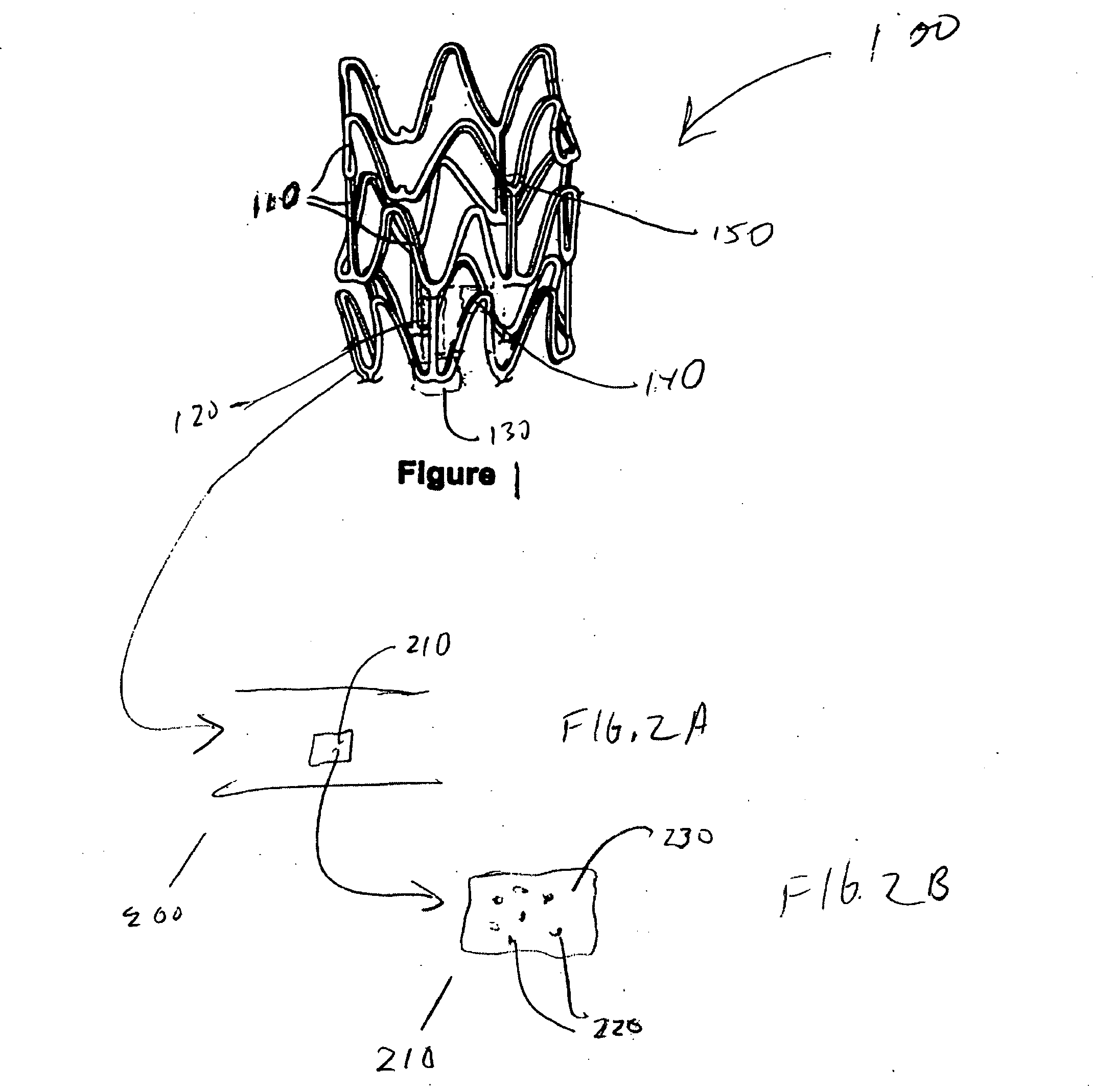Polymer-bioceramic composite implantable medical devices
- Summary
- Abstract
- Description
- Claims
- Application Information
AI Technical Summary
Benefits of technology
Problems solved by technology
Method used
Image
Examples
example 1
Prophetic Example of Solution Blending of Polymer and Bioceramic Particles
[0125]Step 1: Add bioceramic particles into suitable solvent, such as chloroform, acetone, etc. and stir to form a bioceramic particle suspension solution.
[0126]Step 2: Slowly add a polymer such as PLLA, PDLLA, PGLA into suspension solution and stir until polymer dissolves completely. In this step, the solution may still have a relatively low viscosity. However, the bioceramic particles should be well dispersed while stirring.
[0127]Step 3: Slowly add the polymer into solution again to gradually increase solution viscosity. Repeat this step as needed until the polymer is completely dissolved and reasonable solution viscosity is developed.
[0128]Step 4: Apply ultrasonic mixing to suspension solution for 15-30 min to further disperse all the HAP uniformly into the PLLA solution.
[0129]Step 6: Add suspension solution to IL methanol to precipitate polymer and particles.
example 2
[0130]Solution Blending of PLLA / HAP Composite (100:1 wt / wt)
[0131]Step 1: Added 50 mg HAP particles into 300 mL of chloroform and stirred for 10-30 minutes to form bioceramic particle suspension solution.
[0132]Step 2: Slowly added 5 g PLLA into suspension solution and stirred about 8 hours to dissolve all polymer.
[0133]Step 3: Applied ultrasonic mixing to suspension solution for 15-30 min to further disperse HAP particles into PLLA solution.
[0134]Step 4: Added suspension solution to 1L methanol to precipitate polymer and particles.
[0135]Step 5: Filtered the precipitate and dried about 8 hours in vacuum oven at 60° C. End product is PLLA / HAP composite. Composites were also made with 2 wt % and 5 wt % HAP.
[0136]Mechanical Properties and Morphology of PLLA / HAP Composite (100:1 wt / wt)
[0137]Tensile testing of the composite samples and a pure PLLA were performed using an Instron tensile tester. Test samples were prepared by hot pressing the PLLA / HAP composites and pure polymer to a thin fi...
example 3
[0139]Solution Blending of PLLA / HAP Composite (2:1 wt / wt) as HAP Intermedium Mixture
[0140]Step 1: Added 25 g HAP particles to 3L chloroform and stirred for 10-30 minutes to form bioceramic particle suspension solution.
[0141]Step 2: Slowly added 50 g PLLA into suspension solution and stirred about 8 hours to dissolve all polymer.
[0142]Step 3: Applied ultrasonic mixing for 15-30 min to further disperse HAP particles into PLLA solution.
[0143]Step 4: Added suspension solution to 9L methanol to precipitate particles and polymer.
[0144]Step 5: Filtered the precipitate and dried about 8 hours in vacuum oven at 60° C. End product is PLLA / HAP composite.
[0145]Extrusion of Precipitated PLLA / HAP (2:1 wt / wt) with PLLA
[0146]Step 1: Broke 2:1 wt / wt composite into small pieces
[0147]Step 2: Mixed 24 g of broken up composite and 376 g PLLA.
[0148]Step 3: Extruded mixture at 216° C.
PUM
| Property | Measurement | Unit |
|---|---|---|
| Temperature | aaaaa | aaaaa |
| Concentration | aaaaa | aaaaa |
| Adhesion strength | aaaaa | aaaaa |
Abstract
Description
Claims
Application Information
 Login to View More
Login to View More - R&D
- Intellectual Property
- Life Sciences
- Materials
- Tech Scout
- Unparalleled Data Quality
- Higher Quality Content
- 60% Fewer Hallucinations
Browse by: Latest US Patents, China's latest patents, Technical Efficacy Thesaurus, Application Domain, Technology Topic, Popular Technical Reports.
© 2025 PatSnap. All rights reserved.Legal|Privacy policy|Modern Slavery Act Transparency Statement|Sitemap|About US| Contact US: help@patsnap.com



